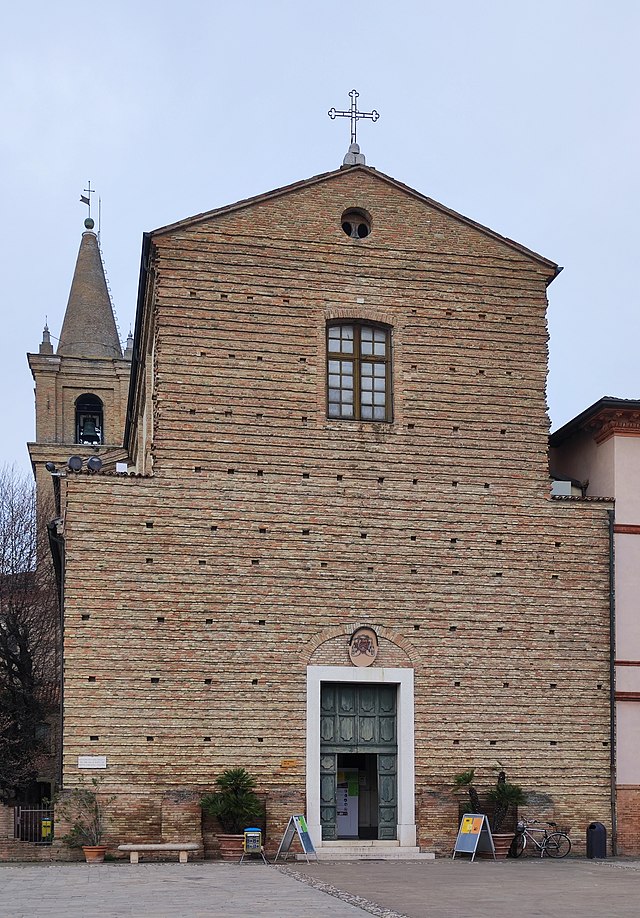Loading AI tools
Roman Catholic diocese in Italy From Wikipedia, the free encyclopedia
The diocese of Cervia was a Roman Catholic diocese in Emilia-Romagna.[1] The diocese was a suffragan of the Archdiocese of Ravenna. In 1947, it merged with the archdiocese of Ravenna to form the Archdiocese of Ravenna-Cervia.[1]

Cervia is a city in the province of Ravenna, Italy, on the ancient Via Flaminia 26.0 km (16.2 mi) south-southeast of Ravenna, in a marshy district near the Adriatic Sea. The town and the diocese were originally called Ficocle (or FIcoclia). In the middle of the 4th century the name was changed to Cervia, though the bishops regularly continued to use the old name.[2] The diocese was a suffragan of Ravenna, according to a document of Pope Gregory I (590–604) now regarded as spurious. It was actually directly subject to the papacy.[3] Pope Agapitus II, in October 948, made Cervia a suffragan of Ravenna.[4] That suffragan status was confirmed by Pope Calixtus II on 7 January 1121, in the bull "Etsi Universae".[5]
The first known Bishop of Cervia was Gerontius. According to his legend,[6] he was returning with Viticanus, Bishop of Cagli, from the Roman council held in 501 to treat accusations made against Pope Symmachus, when he was assaulted and killed by bandits. The legend says "heretics", perhaps Goths, or more probably Heruli, of the army of Odoacer. His remains are preserved at Cagli. He is venerated as a martyr, and is commemorated in the liturgical calendar on May 9.
In 708, the city of Cagli was destroyed by a fire. It was slowly rebuilt.[7]
According to Bonizo of Sutri, a bishop of Cervia participated in the enthronement of the Antipope Clement III (Wibert, Archbishop of Ravenna) in the Lateran Basilica in Rome on 28 June 1083: "a Mutinensie episcopo et a Bononiensi episcopo et a Cerviensis."[8] The manuscript reading, however, is Cueniensi. No other author names a bishop of Cervia. Gebhard of Salzburg names only two bishops;[9] likewise, Bernoldus of Konstanz.[10]
During the episcopate of Bishop Rusticus (1219), in 1224 Cervia was placed under an interdict for its maltreatment of a certain Gerardus, an envoy of the Archbishop of Ravenna. They also abused a procurator of bishop Egidio of Forlimpopoli, who had been sent to announce the interdict.[11]
Other bishops worth mention were: Bishop Joannes (c. 858–881), who was sent on a diplomatic mission by Pope Nicholas I to the court of King Lothair II of Lotharingia;[12] the Venetian Pietro Barbo (1440), later Pope Paul II; Alfonso Visconti (1591–1601), who had been nuncio to the emperor (1589–1591) and to Transylvania (1595–1596);[13] and Bonifacio Bevilacqua (1601–1627),[14] named a Cardinal by Pope Clement VIII on 3 March 1599, and a friend of Pope Gregory XV (Ludovisi), who made him Duke of Fornano.
In 1484, the town of Cervia was destroyed by an earthquake. The Major Council of Ravenna discussed rebuilding the town.[15]
Bishop Ottavio Santacroce (1576–1581) held a diocesan synod in 1577.[16]
On 16 June 1641, Cervia was heavily damaged by a major earthquake. In expiation, the bishop and magistrates instituted an annual procession from the city to Santa Maria del Pino, bearing the remains of the martyr S. Rogatus.[17]
In 1766, the city of Cervia, which was subject to the civil jurisdiction of the papacy in the legation of the Romandiola, contained around 800 persons.[18]
The cathedral of Cervia was dedicated to the taking up of the body (Assumption) of the Virgin Mary into heaven. It was administered and staffed by a corporation called the Chapter, consisting of two dignities (the Archdeacon and the Provost) and eight canons.[19]
In the 19th century, the diocese was composed of only 12 parishes, the entire city of Cervia composing one of those parishes.[20]
On 22 February 1947, the diocese of Cervia was suppressed, and its territory incorporated into the archdiocese of Ravenna.[21]
Erected: 6th Century
Metropolitan: Archdiocese of Ravenna
Seamless Wikipedia browsing. On steroids.
Every time you click a link to Wikipedia, Wiktionary or Wikiquote in your browser's search results, it will show the modern Wikiwand interface.
Wikiwand extension is a five stars, simple, with minimum permission required to keep your browsing private, safe and transparent.